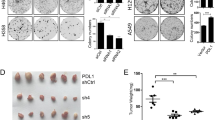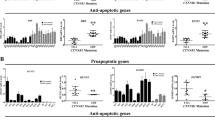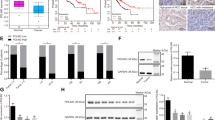Abstract
We have found that a malignant mesothelioma cell line, NCI-H28, had a chromosome 3p21.3 homozygous deletion containing the β-catenin gene (CTNNB1), which suggested that the deletion of β-catenin might have a growth advantage in the development of this tumor. To determine whether β-catenin has a growth-inhibitory activity, we transfected wild-type β-catenin, Ser37Cys mutant β-catenin as an activated type, and C-terminus deletion mutant β-catenin that lacks the transcription activity, into the NCI-H28 cells. A non-small cell lung cancer cell line, NCI-H1299, which expressed endogenous β-catenin, was also studied. We tested the localization of exogenous β-catenin in the NCI-H28 cells with immunofluorescence, and found that the wild-type β-catenin and the C-terminus deletion mutant were more strongly expressed in the plasma membrane and cytoplasm than in the nucleus, while the Ser37Cys mutant was more in the nucleus than in the cytoplasm. By using luciferase-reporter assay, the β-catenin/T-cell factor 4-mediated transactivity of the Ser37Cys mutant was shown to be higher than that of the wild-type β-catenin in both cell lines. However, the transactivity of the C-terminus deletion mutant was strongly reduced in both. Colony formation of the NCI-H28 cells was reduced by 50% after transfection with the wild-type β-catenin, and 60% with the Ser37Cys mutant, but only 20% with the C-terminus deletion mutant compared to the vector control. Inhibition of colony formation in NCI-H28 cells was because of apoptosis, manifested by positive staining of Annexin V and TUNEL assays in transfected cells. In contrast, when transfected with the wild-type β-catenin, no significant reduction in colony formation was seen in β-catenin wild-type NCI-H1299 cells. In conclusion, our data indicate that inactivation of β-catenin by a 3p21.3 homozygous deletion might be a crucial event in the development of the mesothelioma NCI-H28 cells. Thus, while β-catenin is well known to be a positive growth-stimulating factor for many human cancers, it can also act as a potential growth suppressor in some types of human cancer cells.
This is a preview of subscription content, access via your institution
Access options
Subscribe to this journal
Receive 50 print issues and online access
$259.00 per year
only $5.18 per issue
Buy this article
- Purchase on Springer Link
- Instant access to full article PDF
Prices may be subject to local taxes which are calculated during checkout






Similar content being viewed by others
References
Ahmed Y, Hayashi S, Levine A and Wieschaus E . (1998). Cell, 93, 1171–1182.
Barth AI, Nathke IS and Nelson WJ . (1997). Curr. Opin. Cell Biol., 9, 683–690.
Bell DW, Jhanwar SC and Testa JR . (1997). Cancer Res., 57, 4057–4062.
Burbee DG, Forgacs E, Zöchbauer-Müller S, Shivakumar L, Fong K, Gao B, Randle D, Kondo M, Virmani A, Bader S, Sekido Y, Latif F, Milchgrub S, Toyooka S, Gazdar AF, Lerman MI, Zabarovsky E, White M and Minna JD . (2001). J. Natl. Cancer Inst., 93, 691–699.
Chen JY, Funk WD, Wright WE, Shay JW and Minna JD . (1993). Oncogene, 8, 2159–2166.
Cheng JQ, Jhanwar SC, Klein WM, Bell DW, Lee WC, Altomare DA, Nobori T, Olopade OI, Buckler AJ and Testa JR . (1994). Cancer Res., 54, 5547–5551.
Cheng JQ, Lee WC, Klein MA, Cheng GZ, Jhanwar SC and Testa JR . (1999). Genes Chromosomes Cancer, 24, 238–242.
Damalas A, Ben-Ze'ev A, Simcha I, Shtutman M, Leal JF, Zhurinsky J, Geiger B and Oren M . (1999). EMBO J., 18, 3054–3063.
Dammann R, Li C, Yoon JH, Chin PL, Bates S and Pfeifer GP . (2000). Nature Genet., 25, 315–319.
Flejter WL, Li FP, Antman KH and Testa JR . (1989). Genes Chrom. Cancer, 1, 148–154.
Fukuchi T, Sakamoto M, Tsuda H, Maruyama K, Nozawa S and Hirohashi S . (1998). Cancer Res., 58, 3526–3528.
Gibas Z, Li FP, Antman KH, Bernal S, Stahel R and Sandberg AA . (1986). Cancer Genet. Cytogenet., 20, 191–201.
Hagemeijer A, Versnel MA, Van Drunen E, Moret M, Bouts MJ, van der Kwast TH and Hoogsteden HC . (1990). Cancer Genet. Cytogenet., 47, 1–28.
Hasegawa S, Sato T, Akazawa H, Okada H, Maeno A, Ito M, Sugitani Y, Shibata H, Miyazaki J, Katsuki M, Yamauchi Y, Yamamura K, Katamine S and Noda T . (2002). Proc. Natl. Acad. Sci. USA, 99, 297–302.
Hayashi S, Rubinfeld B, Souza B, Polakis P, Wieschaus E and Levine AJ . (1997). Proc. Natl. Acad. Sci. USA, 94, 242–247.
He TC, Sparks AB, Rago C, Hermeking H, Zawel L, da Costa LT, Morin PJ, Vogelstein B and Kinzler KW . (1998). Science, 281, 1509–1512.
Iwao K, Nakamori S, Kameyama M, Imaoka S, Kinoshita M, Fukui T, Ishiguro S, Nakamura Y and Miyoshi Y . (1998). Cancer Res., 58, 1021–1026.
Kim K, Pang KM, Evans M and Hay ED . (2000). Mol. Biol. Cell, 11, 3509–3523.
Kinzler KW and Vogelstein B . (1996). Cell, 87, 159–170.
Lee WC, Balsara B, Liu Z, Jhanwar SC and Testa JR . (1996). Cancer Res., 56, 4297–4301.
Liu C, Kato Y, Zhang Z, Do VM, Yankner BA and He X . (1999). Proc. Natl. Acad. Sci. USA, 96, 6273–6278.
Lu YY, Jhanwar SC, Cheng JQ and Testa JR . (1994). Genes Chromosomes Cancer, 9, 76–80.
Miyoshi Y, Iwao K, Nagasawa Y, Aihara T, Sasaki Y, Imaoka S, Murata M, Shimano T and Nakamura Y . (1998). Cancer Res., 58, 2524–2527.
Morin PJ, Sparks AB, Korinek V, Barker N, Clevers H, Vogelstein B and Kinzler KW . (1997). Science, 275, 1787–1790.
Polakis P . (2000). Genes Dev., 14, 1837–1851.
Popescu NC, Chahinian AP and DiPaolo JA . (1988). Cancer Res., 48, 142–147.
Rubinfeld B, Albert I, Porfiri E, Fiol C, Munemitsu S and Polakis P . (1996). Science, 272, 1023–1026.
Rubinfeld B, Robbins P, El-Gamil M, Albert I, Porfiri E and Polakis P . (1997). Science, 275, 1790–1792.
Sakanaka C, Weiss JB and Williams LT . (1998). Proc. Natl. Acad. Sci. USA, 95, 3020–3023.
Sakanaka C and Williams LT . (1999). J. Biol. Chem., 274, 14090–14093.
Sekido Y, Sato M, Usami N, Shigemitsu K, Mori S, Maeda O, Yokoi T, Hasegawa Y, Yoshioka H and Shimokata K . (2002). Cancer Genet. Cytogenet., 132, 33–42.
Shigemitsu K, Sekido Y, Usami N, Mori S, Sato M, Horio Y, Hasegawa Y, Bader SA, Gazdar AF, Minna JD, Hida T, Yoshioka H, Imaizumi M, Ueda Y, Takahashi M and Shimokata K . (2001). Oncogene, 20, 4249–4257.
Shivapurkar N, Virmani AK, Wistuba, II, Milchgrub S, Mackay B, Minna JD and Gazdar AF . (1999). Clin. Cancer Res., 5, 17–23.
Sozzi G, Veronese ML, Negrini M, Baffa R, Cotticelli MG, Inoue H, Tornielli S, Pilotti S, De Gregorio L, Pastorino U, Pierotti MA, Ohta M, Huebner K and Croce CM . (1996). Cell, 85, 17–26.
Su LK, Vogelstein B and Kinzler KW . (1993). Science, 262, 1734–1737.
Sunaga N, Kohno T, Kolligs FT, Fearon ER, Saito R and Yokota J . (2001). Genes Chromosomes Cancer, 30, 316–321.
Taguchi T, Jhanwar SC, Siegfried JM, Keller SM and Testa JR . (1993). Cancer Res., 53, 4349–4355.
Taniguchi K, Roberts LR, Aderca IN, Dong X, Qian C, Murphy LM, Nagorney DM, Burgart LJ, Roche PC, Smith DI, Ross JA and Liu W . (2002). Oncogene, 21, 4863–4871.
Tetsu O and McCormick F . (1999). Nature, 398, 422–426.
Tiainen M, Tammilehto L, Mattson K and Knuutila S . (1988). Cancer Genet. Cytogenet., 33, 251–274.
van Gijn ME, Snel F, Cleutjens JP, Smits JF and Blankesteijn WM . (2001). Exp. Cell Res., 265, 46–53.
Wistuba, II, Behrens C, Virmani AK, Mele G, Milchgrub S, Girard L, Fondon JW 3rd, Garner HR, McKay B, Latif F, Lerman MI, Lam S, Gazdar AF and Minna JD . (2000). Cancer Res., 60, 1949–1960.
Yost C, Torres M, Miller JR, Huang E, Kimelman D and Moon RT . (1996). Genes Dev., 10, 1443–1454.
Zhang Z, Hartmann H, Do VM, Abramowski D, Sturchler-Pierrat C, Staufenbiel M, Sommer B, van de Wetering M, Clevers H, Saftig P, De Strooper B, He X and Yankner BA . (1998). Nature, 395, 698–702.
Acknowledgements
We thank Dr Bert Vogelstein for the pGL3-OT and pGL3-OF reporter plasmids, Dr Adi F Gazdar for the NCI-H1299 cell line, and Ms Hiroko Kako and Ms Yumie Narita for technical support. This work was supported in part by a Grant-in-Aid from the Japan Society for the Promotion of Science to YS, and NCI Grants P50 CA70907 and CA71618 to JDM.
Author information
Authors and Affiliations
Corresponding author
Rights and permissions
About this article
Cite this article
Usami, N., Sekido, Y., Maeda, O. et al. β-catenin inhibits cell growth of a malignant mesothelioma cell line, NCI-H28, with a 3p21.3 homozygous deletion. Oncogene 22, 7922–7930 (2003). https://doi.org/10.1038/sj.onc.1206533
Received:
Revised:
Accepted:
Published:
Issue Date:
DOI: https://doi.org/10.1038/sj.onc.1206533
Keywords
This article is cited by
-
The role of TGFBI in mesothelioma and breast cancer: association with tumor suppression
BMC Cancer (2012)
-
Identification of IGFBP-6 as an effector of the tumor suppressor activity of SEMA3B
Oncogene (2008)
-
Transcriptional silencing of secreted frizzled related protein 1 (SFRP1) by promoter hypermethylation in non-small-cell lung cancer
Oncogene (2005)
-
Plakoglobin (γ-catenin) has TCF/LEF family-dependent transcriptional activity in β-catenin-deficient cell line
Oncogene (2004)



